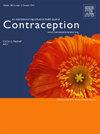DEVELOPMENT OF A DILATION AND EVACUATION SIMULATOR AND TRAINING CURRICULUM
IF 2.3
2区 医学
Q1 OBSTETRICS & GYNECOLOGY
引用次数: 0
Abstract
Objectives
We aimed to develop a low-cost, low fidelity dilation and evacuation simulator and training program. We sought to increase resident exposure, skills, and confidence with dilation and evacuation in an abortion-restrictive state.
Methods
The dilation and evacuation simulator was based on previously designed and tested simulators. A basic learning module was developed. Providers experienced in dilation and evacuation tested the model to assess for accuracy of simulation. The simulator was incorporated into resident didactic time and pre- and post-tests assessed knowledge, skills, and confidence in dilation and evacuation.
Results
Participating residents were evenly split between PGY-1 or 2 (n=5) and PGY-3 or 4 (n=5) training levels. Residents demonstrated improvement in knowledge of dilation and evacuation with average pretest score of 73.2% and average post test score of 90%. Prior to simulation, 80% of residents reported they knew the steps of a dilation and evacuation but only 50% felt comfortable performing one with supervision. Experienced providers felt that the cervical dilation was either realistic or very realistic, and that the simulation of calvarium, placenta, and fetal parts was somewhat realistic or neither realistic nor unrealistic.
Conclusions
Low-cost simulation can provide a reasonably realistic simulation of dilation and evacuation. Simulation is an effective way to improve resident knowledge and comfort with this procedure. Strengths of this study include a cohort evenly split by training levels and by residents who trained before and after restrictive abortion laws were in place. Limitations include limited number of experienced providers for simulator testing and lack of assessment of resident comfort or skills after training on the simulator.
开发膨胀和疏散模拟器和培训课程
目的:开发一种低成本、低保真度的扩张和疏散模拟器及训练程序。我们试图增加住院医生在限制流产状态下的扩张和疏散的暴露、技能和信心。方法在先前设计和测试的模拟装置的基础上,制作膨胀和疏散模拟装置。开发了一个基本的学习模块。具有扩张和疏散经验的提供者对模型进行了测试,以评估模拟的准确性。该模拟器被纳入住院医师的教学时间和前后测试评估的知识,技能和信心扩张和疏散。结果参与住院医师平均分为PGY-1或2 (n=5)和PGY-3或4 (n=5)培训水平。居民在扩张和疏散知识方面表现出改善,平均测试前得分为73.2%,平均测试后得分为90%。在模拟之前,80%的居民报告说他们知道扩张和疏散的步骤,但只有50%的人觉得在监督下执行这些步骤很舒服。经验丰富的医生认为宫颈扩张要么是现实的,要么是非常现实的,对颅骨、胎盘和胎儿部位的模拟有些现实,要么既不现实也不现实。结论慢成本模拟可以提供较为真实的膨胀和疏散模拟。模拟是提高住院医师对该程序的了解和熟练程度的有效途径。这项研究的优势包括按培训水平和在限制性堕胎法实施之前和之后接受培训的住院医生平均划分的队列。限制包括有经验的模拟器测试提供者数量有限,以及在模拟器培训后缺乏对居民舒适度或技能的评估。
本文章由计算机程序翻译,如有差异,请以英文原文为准。
求助全文
约1分钟内获得全文
求助全文
来源期刊

Contraception
医学-妇产科学
CiteScore
4.70
自引率
17.20%
发文量
211
审稿时长
69 days
期刊介绍:
Contraception has an open access mirror journal Contraception: X, sharing the same aims and scope, editorial team, submission system and rigorous peer review.
The journal Contraception wishes to advance reproductive health through the rapid publication of the best and most interesting new scholarship regarding contraception and related fields such as abortion. The journal welcomes manuscripts from investigators working in the laboratory, clinical and social sciences, as well as public health and health professions education.
 求助内容:
求助内容: 应助结果提醒方式:
应助结果提醒方式:


